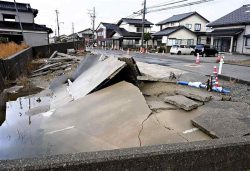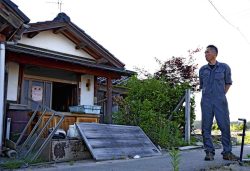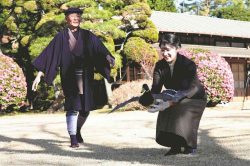District Cut Off By Japan Quake Accessible After 12 Days; Many Evacuees Still Forced to Shelter in Vehicles
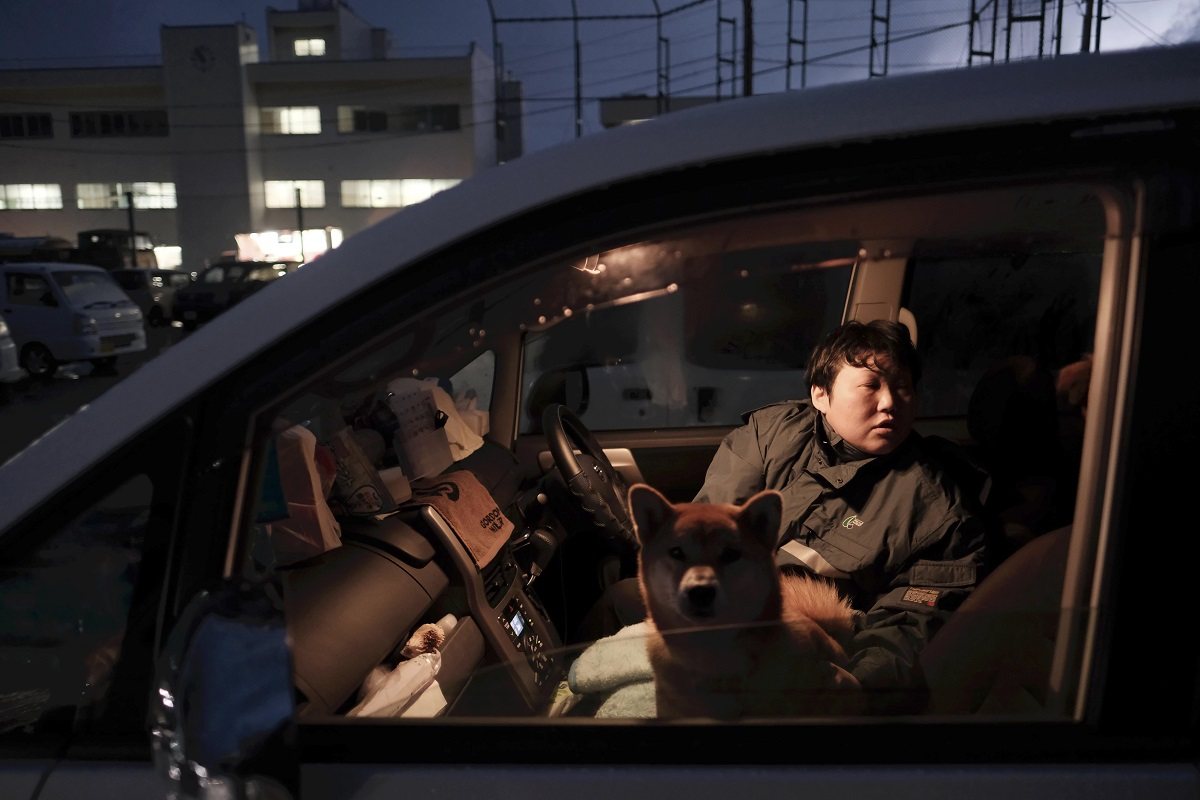
Yuka Yamanaka stays in her car with her dog on the premises of an elementary school in Wajima, Ishikawa Prefecture, on Saturday.
16:03 JST, January 14, 2024
A cut-off district in Wajima, Ishikawa Prefecture, has finally become accessible, 12 days after a national highway was blocked due to a landslide triggered by the Noto Peninsula Earthquake on Jan. 1.
The Land, Infrastructure, Transport and Tourism Ministry completed work to temporarily open National Highway Route 249 on Saturday. As soon as the road became passable at 10 a.m., cars from the Konosu district headed to the city center one after another, driving past the remaining earth and sand.
“It’s been a really long time,” a resident said with relief. However, many people looked exhausted as the prospects for their lives as evacuees remained uncertain.
About 170 people are staying at Konosu Elementary School and the Konosu community center, which are serving as evacuation centers for the district. They had to carry water and food on foot over steep slopes until the Self-Defense Forces began transporting supplies by helicopter Tuesday.
“Now we can expect electricity and running water to be restored,” said Kanako Yamashita, 34, who was running an evacuation center.
Mitsuo Sako, 74, had evacuated to the elementary school. “I can finally go shopping and go to the hospital by car,” Sako said.
Even after the road reopened, however, most of the residents had nowhere to go. Many said they would remain in the evacuation centers until a secondary evacuation site is arranged for them.
According to the Ishikawa prefectural government, at one point there were 24 districts with 3,345 people in the prefecture that were difficult to reach. Some areas have been cut off due to more recent landslides, and there are now 15 districts with 793 people isolated.
“We’re aiming to resolve the situation by the end of this month,” Gov. Hiroshi Hase told reporters Saturday.
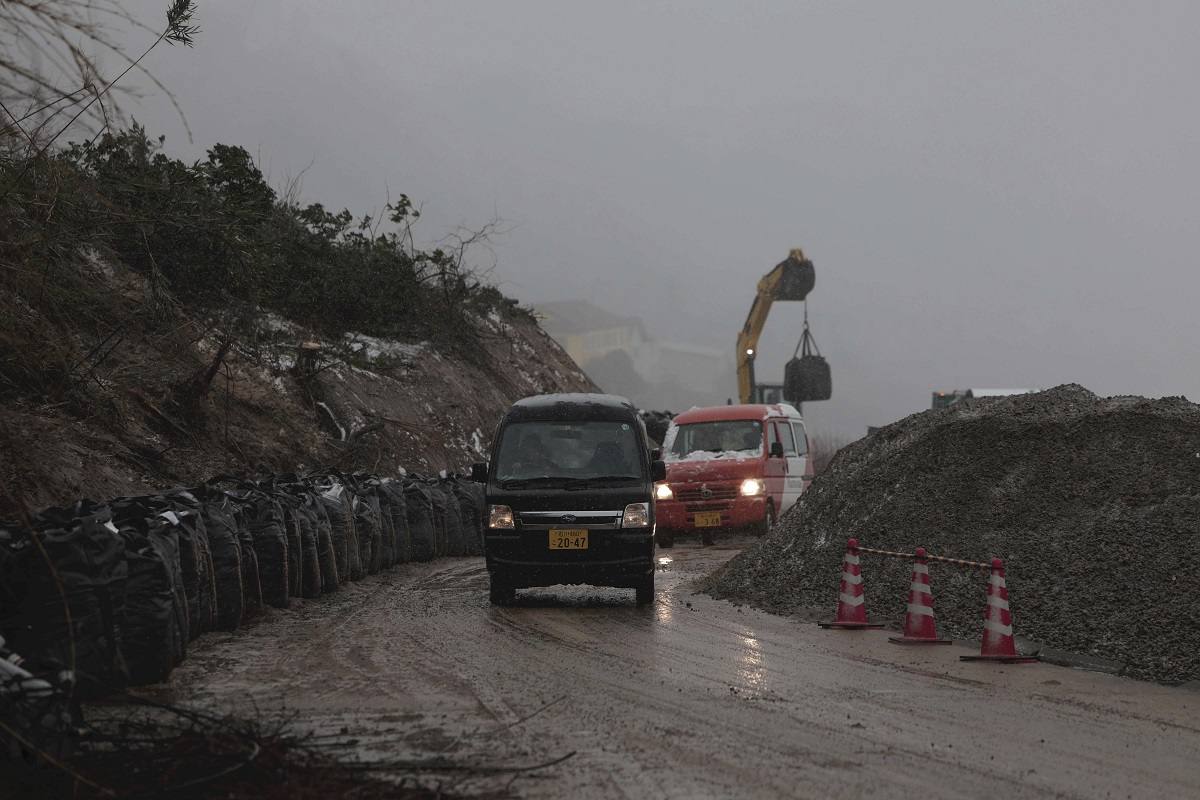
Cars pass Saturday afternoon on National Highway Route 249, which connects the Konosu district in Wajima, Ishikawa Prefecture, and the city center.
Many stay in cars
More districts have gradually become accessible, but many evacuees are being forced to stay in such environments as their cars in bitter cold weather.
At Fugeshi Elementary School in Wajima, many of the about 80 cars parked on the premises had their inside lights on even when it was snowing on Saturday night.
Yuka Yamanaka, a 47-year-old nursing care home worker, has been sleeping in a passenger car with her eldest son, Kasei, 20, since Jan. 4 because they have two dogs and cannot stay inside the gym. She turns off the engine during the daytime to save gasoline.
“My legs are swollen, and I can’t physically take this anymore,” she said. “I just want to lie down in a spacious place.”
In the city’s Nagaimachi district, about 20 residents were staying in a greenhouse. It was provided by Yasuo and Mitsue Bo, a couple in their 60s, because a community center that was supposed to be used as an evacuation center was damaged by the disaster.
The evacuees brought blankets, blue sheets and a stove among other items to the greenhouse to keep out the cold.
“The people staying here are our neighbors, whom we know very well. The young people help us out, and we’re grateful for that,” said Mitsue Bo. However, the bitter cold weather and snow make the evacuees’ lives difficult.
“It’s an old facility, so I’m worried that it might be crushed by the snow. I hope it somehow survives until temporary housing is ready for us,” said Yasuo Bo.
"Society" POPULAR ARTICLE
-

M4.9 Earthquake Hits Tokyo, Neighboring Prefectures
-

M7.5 Earthquake Hits Northern Japan; Tsunami Waves Observed in Hokkaido, Aomori and Iwate Prefectures
-

Tsukiji Market Urges Tourists to Avoid Visiting in Year-End
-

Israeli Tourists Refused Accommodation at Hotel in Japan’s Nagano Pref., Prompting Protest by Israeli Embassy and Probe by Prefecture
-

Beloved Cat Stationmaster Nitama in Wakayama Pref. Passes Away at 15
JN ACCESS RANKING
-

Keidanren Chairman Yoshinobu Tsutsui Visits Kashiwazaki-Kariwa Nuclear Power Plant; Inspects New Emergency Safety System
-

Imports of Rare Earths from China Facing Delays, May Be Caused by Deterioration of Japan-China Relations
-

Japan Exports Rise in October as Slump in U.S. Sales Eases
-

Japan Pulls out of Vietnam Nuclear Project, Complicating Hanoi’s Power Plans
-

Govt Aims to Expand NISA Program Lineup, Abolish Age Restriction



